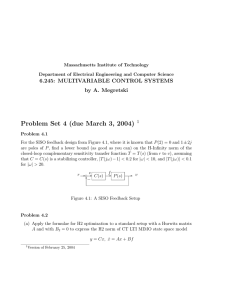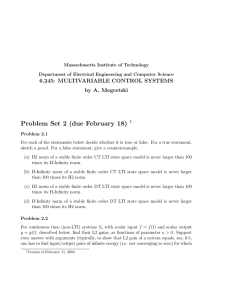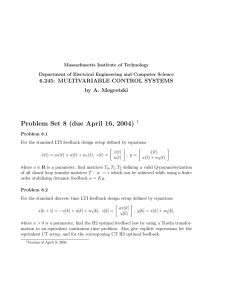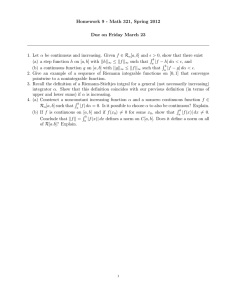Massachusetts Institute of Technology
advertisement
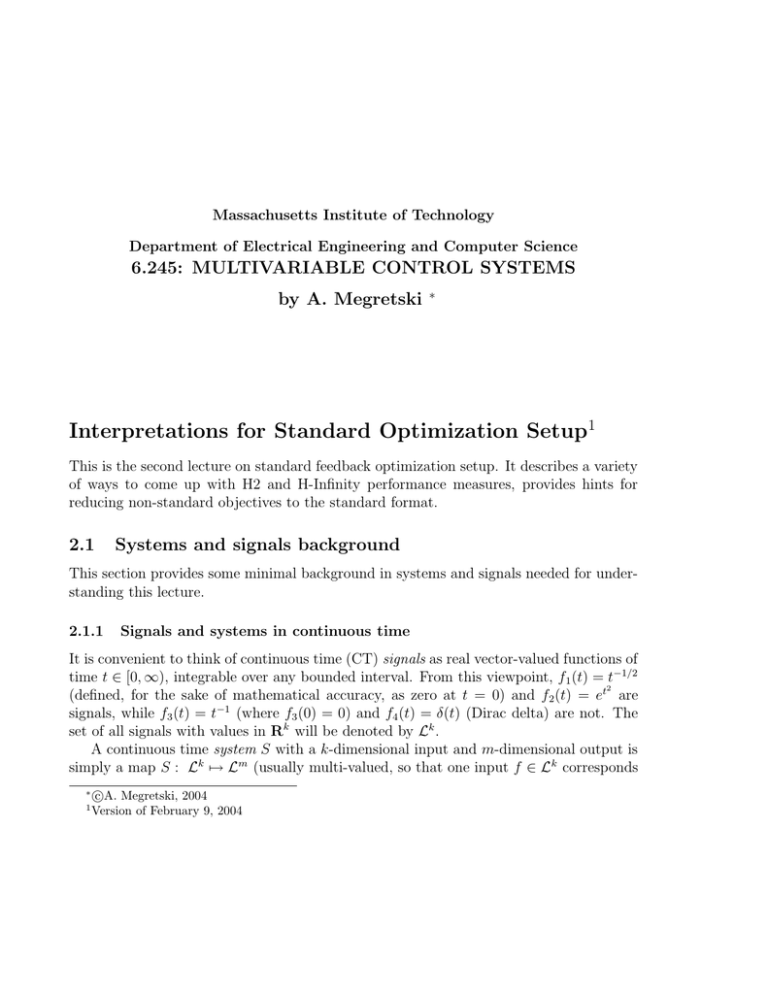
Massachusetts Institute of Technology
Department of Electrical Engineering and Computer Science
6.245: MULTIVARIABLE CONTROL SYSTEMS
by A. Megretski
�
Interpretations for Standard Optimization Setup1
This is the second lecture on standard feedback optimization setup. It describes a variety
of ways to come up with H2 and H-Infinity performance measures, provides hints for
reducing non-standard objectives to the standard format.
2.1
Systems and signals background
This section provides some minimal background in systems and signals needed for under­
standing this lecture.
2.1.1
Signals and systems in continuous time
It is convenient to think of continuous time (CT) signals as real vector-valued functions of
time t ≤ [0, →), integrable over any bounded interval. From this viewpoint, f 1 (t) = t−1/2
2
(defined, for the sake of mathematical accuracy, as zero at t = 0) and f2 (t) = et are
signals, while f3 (t) = t−1 (where f3 (0) = 0) and f4 (t) = �(t) (Dirac delta) are not. The
set of all signals with values in Rk will be denoted by Lk .
A continuous time system S with a k-dimensional input and m-dimensional output is
simply a map S : Lk ∞� Lm (usually multi-valued, so that one input f ≤ Lk corresponds
A. Megretski, 2004
Version of February 9, 2004
�
c
1
2
to many possible outputs g ≤ Lm ). For example, the familiar pure integrator system
(transfer function 1/s) maps a signal f ≤ L1 to signals of the form
t
g(t) = c0 +
f (δ )dδ,
0
where c0 is an arbitrary constant. In general, a system’s output is not necessarily unique
because it may also depend on a set of auxiliary parameters (e.g. the initial states of
the system), as in Figure 2.1. In the case of the pure integrator system described above,
initial state
input�
�
system
output
�
Figure 2.1: System with initial conditions
constant c0 plays the role of an initial state.
2.1.2
Signals and systems in discrete time
Let us view discrete time (DT) signals are continuous time signals which only change
value at a discrete set of uniformly spaced time instances tk = kT , where T > 0 is a fixed
real number called the sampling rate of a DT signal, and k is a non-negative integer. The
usual meaning of a discrete time signal is that at every time t � 0 it represents the last
available sample of a continuous time signal, provided the samples are taken uniformly
with interval T starting at zero time. For example, sampling CT signal f (t) = cos(�t) at
rate T = 1 yields a discrete-time signal
�
1,
k � t < k + 1, k ≤ {0, 2, 4, . . . },
fd (t) =
.
−1, k � t < k + 1, k ≤ {1, 3, 5, . . . }
Note that this fd can also be viewed as a DT signal at sampling rate 1/M for every
positive integer M (though, indeed, it will not be the result of sampling f (t) = cos(�t)
at rate T = 1/M for M ≥= 1).
An alternative way of representing a discrete time signal f = f (t) with sampling rate
T > 0 is by specifying T and the sequence of its values f [k] at time instances tk = kT ,
i.e.
f [k] = f (kT ), k = 0, 1, 2, . . . .
3
Thus, a DT signal f (t) is completely defined by its sampling rate T and by the sequence
of sampled values f [k] = f (kT ). For example, the DT signal fd (t) from above can be
defined as such with sampling rate T = 1 and sampled values sequence fd [k] = (−1)k .
The set of all discrete time k-dimensional signals at sampling rate T will be denoted
by Lk[T ] .
A discrete time system S is a map S : Lk[T ] ∞� Lm
[T ] (usually multi-valued). Note
that this definition requires same sampling rates for input and output. Therefore, a DT
system with a k-dimensional input and m-dimensional output can also be viewed as a
q
m
k
denotes the set of all sequences f = f [k] of q-dimensional
, where l+
∞� l+
map S : l+
real vectors, indexed by non-negative integers k. For example, the familiar one step delay
system (transfer function 1/z) maps f = f [k] into g[k] = f [k − 1], with the value of g[0]
being arbitrary.
2.1.3
Finite Order CT LTI Models
A state-space model for a finite order CT LTI system H with input f = f (t), output
g = g(t), and state x = x(t) has the form
ẋ(t) = Ax(t) + Bf (t),
g(t) = Cx(t) + Df (t),
(2.1)
(2.2)
where A, B, C, D are constant matrices with real entries.
�
�
A B
H=
C D
frequently serves as a shortcut notation. Given an input f = f (t), the output g = g(t) is
defined by the initial state vector x(0), according to the formula
t
At
g(t) = Ce x(0) + Df (t) +
CeA� Bf (t − δ )dδ.
0
The transfer matrix (transfer function in the case when both f and g are scalar) of the
system is defined for all complex s such that sI − A is invertible by
H(s) = D + C(sI − A)−1 B.
4
2.1.4
Finite Order DT LTI Models
A state-space model for a finite order DT LTI system H with input f = f (t), output
g = g(t), and state x = x(t) has the form
x(t + T ) = Ax(t) + Bf (t),
g(t) = Cx(t) + Df (t),
(2.3)
(2.4)
where A, B, C, D are constant matrices with real entries. Here f, g, x are DT signals
with same sampling rate T > 0. In terms of sampled value sequences f [k] = f (kT ),
x[k] = x(kT ), and g[k] = g(kT ), equations have the form
x[k + 1] = Ax[k] + Bf [k],
g[k] = Cx[k] + Df [k],
(2.5)
(2.6)
The transfer matrix (transfer function in the case when both f and g are scalar) of the
system is defined for all complex z such that zI − A is invertible by
H(z) = D + C(zI − A)−1 B.
2.2
Interpretations for H-Infinity and H2 norms
H-Infinity and H2 norms are frequently used as the cost measure in feedback optimization.
This section describes interpretations of the norms as performance measures.
2.2.1
H-Infinity and H2 norms for finite order LTI systems
Let
H=
�
A B
C D
�
be a finite order state space CT LTI model. The model is called stable if A is a Hurwitz
matrix, i.e. if all eigenvalues of A have negative real part.
The H-Infinity norm ∈H∈� of H is defined as the supremum (minimal upper bound)
of the largest singular number of its transfer function over the imaginary axis:
∈H∈� = sup �max (H(jσ)),
�→R
where
H(s) = D + C(sI − A)−1 B,
5
and, for an k-by-m complex matrix M ,
�max (M ) =
max
m
u→C , |u|=1
|M u|,
and |v| denotes the standard Hermitean norm (length) of vector v.
If H is a discrete time system, maximization over the imaginary axis is replaced with
maximization over the unit circle:
sup �max (H(ej� )).
∈H∈� =
�→[−�,�]
The H2 norm ∈H∈2 of a finite order stable CT LTI system H with D = 0 is defined
by the integral
�
�
1
2
≥
trace(H(jσ)H(jσ)≥ )dσ,
∈H∈2 =
trace(h(t)h(t) )dt =
2� −�
0
where
h(t) = CeAt B
is the impulse response matrix of H.
In the discrete time case (where D =
≥ 0 is allowed), the H2 norm is defined by
∈H∈22
2.2.2
�
�
1
= trace(D D) +
traceB (A ) C CA B =
2�
k=0
≥
≥
≥ k
≥
k
�
trace(H(ej� )H(ej� )≥ dσ.
−�
H-Infinity norm as L2 gain
The L2 (strictly speaking, “L2-to-L2”) gain of a continuous time system S with input f
and output g is defined as the minimal π � 0 such that
T
inf
{π 2 |f (t)|2 − |g(t)|2 }dt > −→
T �0
0
for all input/output pairs g = S(f ) where input f is square integrable over arbitrary finite
intervals. The definition for discrete time systems is similar, with integrals replaced by
sums:
N
�
inf
{π 2 |f [k]|2 − |g[k]|2 } > −→,
N �0
k=0
6
where g = S(f ).
The informal rationale behind the definition is as follows: for “zero initial conditions”
(whatever this means), we expect the “energy” of the output to be bounded by the energy
of the input times the L2 gain squared. Since non-zero initial conditions can produce non­
zero output even for zero input, the actual definition says that the difference between the
energies must be bounded on one side.
L2 gain is a key concept in robustness analysis. The importance of the H-Infinity
norm is largely due to the fact that, for a stable finite order LTI system, H-Infinity norm
equals L2 gain.
Theorem 2.1 L2 gain of a stable finite order LTI system equals its H-Infinity norm.
Proof Consider the continuous time case (the DT case is similar). Let H = H(s) be the
transfer function of the system.
To show that L2 gain cannot be larger than H-Infinity norm, use the Parceval theorem.
Consider the case of zero initial conditions first. For an arbitrary input signal f and for
T > 0 let fT denote the signal defined by
�
f (t), t < T,
fT (t) =
0,
t � T.
Let g and g T denote the response of the system to f and fT respectively, both assuming
zero initial conditions. Then fT , g T are square integrable over t ≤ (0, →) (for g T this is
true since A is a Hurwitz matrix), and hence both have Fourier transforms f˜T and g˜T
respectively. In addition, by causality, g(t) = g T (t) for t < T . Hence
T
T
�
2
T
2
|g(t)| dt =
|g (t)| dt �
|g T (t)|2 dt
0
0
0
�
1
g T (jσ)|2 dσ =
|˜
=
2� −�
�
1
=
|H(jσ)f˜T (jσ)|2 dσ
2� −�
�
2
2
2
2
2
|fT (t)| dt = ∈H∈�
∈H∈� |fT (jσ)| dσ = ∈H∈�
�
T
1
|f (t)|2 dt.
�
2� −�
0
0
In the case of non-zero initial conditions the total system response is given by g =
g0 + g1 , where g0 is the zero state response and g1 is zero input response. Since A is a
Hurwitz matrix, g1 is square integrable over t ≤ (0, →). Hence, for every τ > 0,
T
T
T
1
2
2
|g(t)| dt � (1 + τ)
|g0 (t)| dt + (1 + )
|g1 (t)|2 dt
τ
0
0
0
7
�
1
|g1 (t)|2 dt.
� (1 +
|f (t)| dt + (1 + )
τ 0
0
To show that H-Infinity norm cannot be larger than L2 gain, consider zero initial
conditions and sinusoidal inputs f (t) = f0 cos(σt), where frequency σ and vector f0 are
appropriately chosen.
τ)∈H∈2�
2.2.3
T
2
H2 norm and L2-to-L-Infinity gain
L2-to-L-Infinity gain of a stable state space model is defined as the supremum of the
amplitude of its time domain response to an input signal of unit energy.
Theorem 2.2 L2-to-L-Infinity gain of a stable LTI system with a scalar output equals
its H2 norm.
Proof Consider the continuous-time case (the DT case is similar).
To show that H2 norm is not smaller than the L2-to-L-Infinity gain, use the standard
Cauchy-Schwartz inequality:
�
T
�
T
T
�
�2
2
2
|y(T )| = ��
h(t)f (T − t)dt�� �
|h(t)| dt
|f (t)|2 dt.
0
0
0
Since the inequality becomes equality for f (t) = h(T − t)≥ , the L2-to-L-Infinity gain
actually equals the H2 norm.
2.2.4
H2 norm and variance of white noise response
H2 norm of a system is also an measure of system sensitivity to white noise input.
Remember that the “weak sense” white noise f = f [k] in discrete time is a sequence
of random variables f [k] with zero mean, unit variance, and zero cross-corellation:
Ef [k] = 0, Ef [k1 ]f [k2 ]≥ = �(k1 , k2 )I,
where �(k1 , k2 ) = 0 for k1 ≥= k2 and �(k, k) = 1 for all k.
The continuous time white noise is a slightly more complicated concept: it is a general­
ized random process f = f (t) (something akin the Dirac delta in the world of deterministic
functions), which can be characterized by its effect in integration: if
t2
γ=
h(t)f (t)dt,
t1
8
where h = h(t) is a row vector of appropriate length, then
t2
2
|h(t)|2 dt.
Eγ = 0, E|γ| =
t1
Combining this information with the definition of H2 norm, one can conclude that, for
a stable LTI system, the asymptotic (as t � →) variance of white noise response equals
square of H2 norm.
2.3
Small gain theorems
Small gain theorems (the well-known one for H-Infinity norms, and the less known one
for H2 norm) are among the main reasons to minimize there performanc measures.
2.3.1
A small gain theorem for H-Infinity
While, formally speaking, H-Infinity optimization designs LTI controllers for LTI systems,
it can be used to design controllers for nonlinear or time-varying systems. The main idea
is to extract all non-LTI components of a model, and put them into an external block,
which will affect the LTI part through an input, and will in turn be driven by an output
of an LTI system, as shown on Figure 2.2, left, where � is the nonlinear/time varying
block, and G is the LTI system.
� �
w1
z1
�
w2 �
w1 �
G
� z2
w2 �
� z1
G
� z2
Figure 2.2: Small gain theorem
The following theorem, a version of the famous small gain condition, allows one to
estimate the L2 gain of the nonlinear feedback system on the left of Figure 2.2 based on
the L2 gain properties of � and G.
9
Theorem 2.3 If G and � separately have L2 gains less than one then the feedback in­
terconnection on Figure 2.2, left, has L2 gain (from w2 to z2 ) less than 1.
Proof Consider the signals consistent with the left diagram of Figure 2.2. By assumption
about �,
T
{|z1 |2 − |w1 |2 }dt > −→.
inf
T >0
0
By assumption about G, for some r ≤ (0, 1),
T
inf
{r|w1 |2 + r|w2 |2 − |z1 |2 − |z2 |2 }dt > −→.
T >0
0
Combining these two conditions yields
T
{r|w2 |2 − |z2 |2 }dt > −→.
inf
T >0
2.3.2
0
Example: L2 gain optimization via small gain theorem
Consider the task of designing a feedback controller for the standard setup shown on
Figure 2.3, where G is an unstable LTI plant with delay,
P (s) =
e−� s
,
s−1
and F is the controller to be designed to guarantee good tracking of the reference input
r at lower frequencies.
r
� � �
−�
F
�
P
�
q
Figure 2.3: Feedback design with delay
We begin by approximating the stable part of P by a lower order transfer function,
while bounding the approximation error:
P (s) = P0 (s) + W (s)�(s),
10
where
e−�
δ
1
−
,
s − 1 1 + 0.5δ 1 + 0.5δ s
1+s
W (s) = 0.042
,
10 + s
and �(s) is known to have H-Infinity norm not larger than one. The corresponding
feedback design diagram are shown below.
P0 (s) =
1
1
s+1
Out1
Transfer Fcn
1
In1
g
Gain
3
Out3
P0
3
In3
LTI System
1/d
Gain1
tau=0.1;
s=tf(’s’);
G0=-(tau/(1+tau/2))/(1+tau*s/2);
w=linspace(0,100,10000);
G0w=squeeze(freqresp(G0,w)).’;
Gw=(exp(-tau*j*w)-exp(-tau))./(j*w-1);
max(abs((G0w-Gw).*(1+j*w/10)./(1+j*w)))
P0=exp(-tau)/(s-1)+G0;
g=5;
d=150;
[A,B,C,D]=linmod2(’lec2_ex1a’);
p=pck(A,B,C,D);
k=hinfsyn(p,1,1,0,20,0.01);
2
2
Out2
In2
0.042*d*(1+s)/(10+s)
LTI System1
11
2.3.3
A small gain theorem for H2
H2 norm, too, can serve as a measure of robustness to white noise perturbations of the
feedback loop gain.
Remember that the usual small gain bound on a CT system � with input f and
output g is an inequality of the form
T
T
2
2
|g(t)| dt � const + π
|f (t)|2 dt,
0
0
where the constant may depend on the input/output pair (f, g). A similar definition can
be given in the discrete time case. When dealing with randomized signals and systems,
the L2 gain bounding condition can be replaced by its “expected value” version
T
T
2
2
E|f (t)|2 dt,
E|g(t)| dt � const + π
0
0
and it is easy to show that the small gain theorem (leading to an H-Infinity norm bound
imposed on the nominal LTI system as a condition of overall stability and performance)
still holds.
Consider now a very special case of a gain-bounded randomized “uncertain” block �.
Let us call a random CT column vector signal g uncorrelated if it has zero mean and
�
t2
�2 t2
�
�
E ��
p(t)g(t)dt�� =
|p(t)|2 E|g(t)|2 dt
t1
t1
for every square integrable row vector function p = p(t). In the discrete time case, simply
require that
� k
�2
k2
2
��
�
�
�
�
E�
p[k]g[k]� =
|p[k]|2 E|g[k]|2
�
�
k=k1
k=k1
for every sequence p = p[k] of row vectors.
Theorem 2.4 Let G be a stable finite order LTI system with two inputs w1 , w2 and two
outputs z1 , z2 (wi , zi can be vectors). Let Gij denote the system describing dependence of
zi on wj . Assume that w is uncorrelated, E|w1 (t)|2 = 1 for all t, ∈G22 ∈22 < 1, and
T
T
2
E|w2 (t)| dt � const +
E|z2 (t)|2 dt,
0
0
for all T . Then
1
lim sup
T ��
T
T
0
E|z1 (t)|2 dt � ∈G11 ∈22 +
∈G12 ∈22 · ∈G21 ∈22
.
1 − ∈G22 ∈22
12
2.3.4
Example: analysis via H2 small gain
Consider a simple example which can be easily solved analytically with or without using
the small gain argument. Consider the randomized first order discrete time dynamical
system
y[k + 1] = (a + bv2 [k])y[k] + v1 [k],
where a, b are known real coefficients, v = [v1 ; v2 ] is a strict sense white noise signal, i.e.
Evi [k]2 = 1, Evi [k] = 0,
and it is known that vi [k] is independent of y[t], vi [t − 1] for all t � k. What is the
asymptotic value of Ey[k]2 as k � →?
This question can be answered easily without relying on the H2 small gain theorem,
because
Ey[k + 1]2 = (a2 + b2 )Ey[k]2 + 1,
which immediately implies that the asymptotic value of Ey[k]2 is infinity unless a2 +b2 < 1,
in which case
1
.
lim sup Ey[k]2 =
k��
1 − a2 − b2
To apply the H2 small gain theorem in this case, use
z1 [k] = z2 [k] = y[k], w1 [k] = v1 [k], w2 [k] = v[k]y[k].
Then z and w are related through an LTI transformation with transfer matrix
� 1
�
b
z−a
z−a
.
G = G(z) =
1
b
z−a
z−a
Assuming |a| < 1,
∈G11 ∈22 = ∈G21 ∈22 =
1
b2
2
2
,
∈G
∈
=
∈G
∈
=
.
12 2
22 2
1 − a2
1 − a2
By the assumptions made about vi [k], signal w = [w1 ; w2 ] is uncorrelated, and Ew2 [k]2 =
Ez2 [k]2 for all k. Hence the small H2 gain theorem applies, and yields the upper bound
N
1 �
∈G12 ∈22 · ∈G21 ∈22
1
lim sup
Ez1 [k]2 � ∈G11 ∈22 +
=
.
2
k��
N k=1
1 − ∈G22 ∈2
1 − a2 − b2
